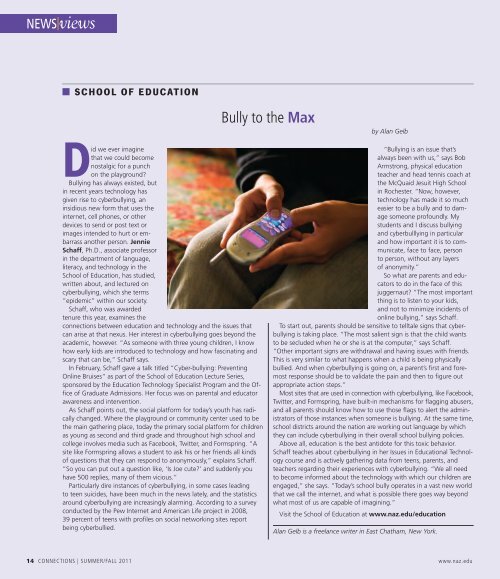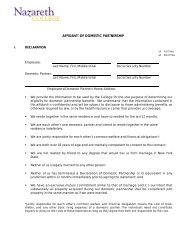SummEr/FAll 2011 - Nazareth College
SummEr/FAll 2011 - Nazareth College
SummEr/FAll 2011 - Nazareth College
You also want an ePaper? Increase the reach of your titles
YUMPU automatically turns print PDFs into web optimized ePapers that Google loves.
NEWS|views<br />
n School of education<br />
Bully to the Max<br />
by Alan Gelb<br />
Did we ever imagine<br />
that we could become<br />
nostalgic for a punch<br />
on the playground?<br />
Bullying has always existed, but<br />
in recent years technology has<br />
given rise to cyberbullying, an<br />
insidious new form that uses the<br />
internet, cell phones, or other<br />
devices to send or post text or<br />
images intended to hurt or embarrass<br />
another person. Jennie<br />
Schaff, Ph.D., associate professor<br />
in the department of language,<br />
literacy, and technology in the<br />
School of Education, has studied,<br />
written about, and lectured on<br />
cyberbullying, which she terms<br />
“epidemic” within our society.<br />
Schaff, who was awarded<br />
tenure this year, examines the<br />
connections between education and technology and the issues that<br />
can arise at that nexus. Her interest in cyberbullying goes beyond the<br />
academic, however. “As someone with three young children, I know<br />
how early kids are introduced to technology and how fascinating and<br />
scary that can be,” Schaff says.<br />
In February, Schaff gave a talk titled “Cyber-bullying: Preventing<br />
Online Bruises” as part of the School of Education Lecture Series,<br />
sponsored by the Education Technology Specialist Program and the Office<br />
of Graduate Admissions. Her focus was on parental and educator<br />
awareness and intervention.<br />
As Schaff points out, the social platform for today’s youth has radically<br />
changed. Where the playground or community center used to be<br />
the main gathering place, today the primary social platform for children<br />
as young as second and third grade and throughout high school and<br />
college involves media such as Facebook, Twitter, and Formspring. “A<br />
site like Formspring allows a student to ask his or her friends all kinds<br />
of questions that they can respond to anonymously,” explains Schaff.<br />
“So you can put out a question like, ‘Is Joe cute?’ and suddenly you<br />
have 500 replies, many of them vicious.”<br />
Particularly dire instances of cyberbullying, in some cases leading<br />
to teen suicides, have been much in the news lately, and the statistics<br />
around cyberbullying are increasingly alarming. According to a survey<br />
conducted by the Pew Internet and American Life project in 2008,<br />
39 percent of teens with profiles on social networking sites report<br />
being cyberbullied.<br />
“Bullying is an issue that’s<br />
always been with us,” says Bob<br />
Armstrong, physical education<br />
teacher and head tennis coach at<br />
the McQuaid Jesuit High School<br />
in Rochester. “Now, however,<br />
technology has made it so much<br />
easier to be a bully and to damage<br />
someone profoundly. My<br />
students and I discuss bullying<br />
and cyberbulllying in particular<br />
and how important it is to communicate,<br />
face to face, person<br />
to person, without any layers<br />
of anonymity.”<br />
So what are parents and educators<br />
to do in the face of this<br />
juggernaut? “The most important<br />
thing is to listen to your kids,<br />
and not to minimize incidents of<br />
online bullying,” says Schaff.<br />
To start out, parents should be sensitive to telltale signs that cyberbullying<br />
is taking place. “The most salient sign is that the child wants<br />
to be secluded when he or she is at the computer,” says Schaff.<br />
“Other important signs are withdrawal and having issues with friends.<br />
This is very similar to what happens when a child is being physically<br />
bullied. And when cyberbullying is going on, a parent’s first and foremost<br />
response should be to validate the pain and then to figure out<br />
appropriate action steps.”<br />
Most sites that are used in connection with cyberbullying, like Facebook,<br />
Twitter, and Formspring, have built-in mechanisms for flagging abusers,<br />
and all parents should know how to use those flags to alert the administrators<br />
of those instances when someone is bullying. At the same time,<br />
school districts around the nation are working out language by which<br />
they can include cyberbullying in their overall school bullying policies.<br />
Above all, education is the best antidote for this toxic behavior.<br />
Schaff teaches about cyberbullying in her Issues in Educational Technology<br />
course and is actively gathering data from teens, parents, and<br />
teachers regarding their experiences with cyberbullying. “We all need<br />
to become informed about the technology with which our children are<br />
engaged,” she says. “Today’s school bully operates in a vast new world<br />
that we call the internet, and what is possible there goes way beyond<br />
what most of us are capable of imagining.”<br />
Visit the School of Education at www.naz.edu/education<br />
Alan Gelb is a freelance writer in East Chatham, New York.<br />
14 CONNECTIONS | Summer/Fall <strong>2011</strong> www.naz.edu

















